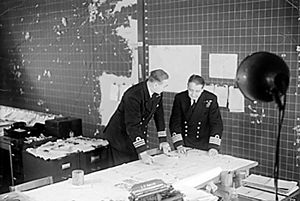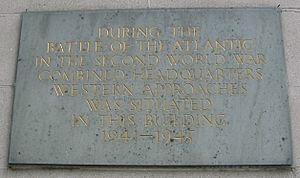Commander-in-Chief, Western Approaches facts for kids
Quick facts for kids Western Approaches Command |
|
|---|---|

Commander RDS Crosse, Staff Officer Convoys, (left) discussing a special convoy movement map with Captain Lake, RN, Duty Officer in the Operations Room at Derby House, Liverpool.
|
|
| Active | 1939–1945 |
| Country | |
| Branch | |
| Type | Military formation |
| Part of | Royal Navy |
| Garrison/HQ | Liverpool |
| Commanders | |
| Notable commanders |
Martin Dunbar-Nasmith (1939–1941) Percy Noble (1941–1942) Max Horton (1942–1945) |
The Commander-in-Chief, Western Approaches was a very important leader in the Royal Navy during World War II. This admiral and their team, sometimes called 'Western Approaches Command,' were in charge of keeping British ships safe. They protected ships sailing in the area known as the Western Approaches, which was a vital sea route.
Contents
Protecting Ships in World War II
Why the Western Approaches Were Important
When World War II began in 1939, Admiral Martin Dunbar-Nasmith was given the big job of protecting the Western Approaches. This area of the Atlantic Ocean, west of Great Britain and Ireland, was where many ships traveled. These ships carried food, supplies, and soldiers to Britain.
After France was taken over in June 1940, the main shipping routes had to change. Ships started sailing around the north of Ireland. This made the Western Approaches even more important for keeping Britain supplied.
A New Headquarters in Liverpool
By late 1940, the command needed a better place to work from. So, the main headquarters moved to Liverpool. On February 7, 1941, it was set up in a building called Derby House. Another control center was built in Magee College in Derry.
Derby House was given a special Navy name, HMS Eaglet. This was a common practice for shore bases. The Royal Air Force also moved its No. 15 Group to Liverpool at the same time. On February 17, 1941, Admiral Sir Percy Noble became the new Commander-in-Chief.
Smart Tactics to Fight Submarines
Admiral Noble worked hard to build up naval bases in places like Greenock, Derry, and Liverpool. He also created training centers. These efforts were key to winning the Battle of the Atlantic against German U-boats (submarines).
The Western Approaches Tactical Unit (WATU)
In January 1942, a special group called the Western Approaches Tactical Unit (WATU) was formed. Its job was to create new ways to fight the German submarines attacking ships. WATU was located on the top floor of Derby House.
Interestingly, WATU was led by Captain Gilbert Roberts and mostly staffed by women. They used special games and models to figure out the best tactics.
Admiral Horton's Support Groups
On November 19, 1942, Admiral Max Horton took over from Admiral Noble. Horton led the command until the war ended in August 1945. His leadership was crucial in defeating the U-boat threat.
Admiral Horton created "support groups" of escort ships. These groups were different because they didn't have to stay with one specific group of ships (a convoy). Instead, they could go wherever a U-boat was spotted. This freedom allowed them to hunt submarines for many hours until they were forced to the surface. This new tactic helped turn the tide of the war at sea.
The Commanders Who Led the Way
These admirals were the leaders of the Western Approaches Command during World War II:
| Rank | Name | Term began | Term ended |
|---|---|---|---|
| Admiral | Martin Dunbar-Nasmith | 9 September 1939 | 17 February 1941 |
| Admiral | Sir Percy Noble | 17 February 1941 | 19 November 1942 |
| Admiral | Max Horton | 19 November 1942 | 15 August 1945 |
Visit the Western Approaches Museum Today
The strong central part of the command bunker at Derby House was too difficult to tear down. So, it has been turned into a museum that you can visit! The museum is called the Western Approaches Museum.
In 2017, a non-profit group called Big Heritage took over the site. They did a lot of work to restore it and even found new hidden parts of the bunker. The museum is now very popular and a great place to learn about this important part of history. During the COVID-19 lockdown, more hidden rooms were found and the main map in the operations room was restored.
See also
- Anti-submarine warfare
- U-boat
- Battle of the Atlantic (1939–1945)



